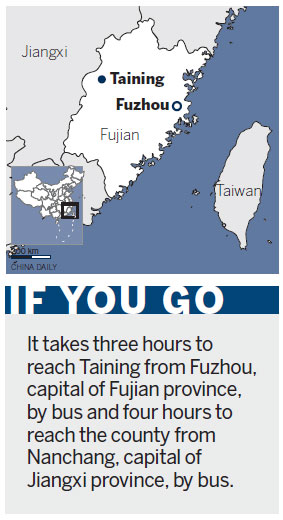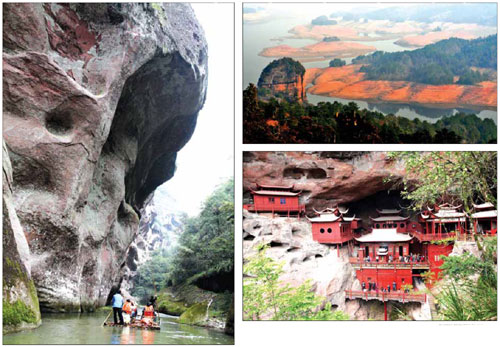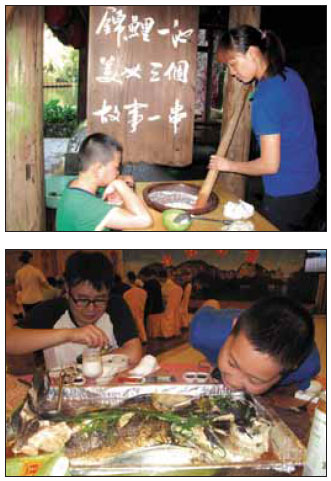|
After an inauspicious and sweltering start to our journey, any initial discomfort makes way for three idyllic days in the calming county of Taining, Huang Zhiling reports.
Not long after the bus leaves Fuzhou, capital of Fujian province, for Taining county, we begin feeling the stifling heat when the air conditioner breaks down with the temperature indicator pointing to 40 C. As it takes time to arrange our transfer to another bus, we end up arriving in Tai-ning, without having dinner, at 9 pm, instead of the scheduled 6 pm arrival.
But the inconvenience of the journey is soon forgotten with a memorable three-day stay in the remote county.
Located at the juncture of Fujian and Jiangxi provinces, Taining is a mountainous county with a population of 141,000.
"It is the third smallest county in Fujian," says Dai Guanrong, a county official.
Taining, which literally means prosperity and peace, remains unknown to many Chinese. It got its name from Emperor Zhezong of the Northern Song Dynasty (960-1127) in 1086.
The county is best known for the Danxia landforms. Danxia, which literally means red rock, refers to red-colored sandstones and formations of the Cretaceous age from 145 to 66 million years ago.
Together with Chishui in Guizhou province, Langshan Mountain in Hunan province, Danxia Mountain in Guangdong province, Longhu Mountain in Jiangxi province and Jianglang Mountain in Zhe-jiang province, Taining became one of China's six Danxia landforms included on the UNESCO's World Natural Heritage list in 2010.
The six areas perfectly demonstrate the entire beauty of Danxia landforms throughout their various ages from early youth to adolescence, post adolescence, early prime of life, early old age and old age.
Representing early youth, the Danxia landforms in Taining cover 2,527 square kilometers and feature fantastic caves varying in size from large to small.
Wondrous caves
One of the best-known caves is in the Zhuangyuan Cliff nearly 12 km from the Taining county seat.
The arc-shaped and winding cave about 100 meters long is believed to be where Zou Yinglong (1173-1245), a poor student from the Taining county seat in the Southern Song Dynasty (1127-1279), studied for five years in order not to be disturbed before taking the imperial exam.
He took the exam and became a scholar with the highest score, or zhuangyuan, at the age of 23.
"Each year, quite a few students who are going to sit for the national college entrance exam visit the Zhuangyuan Cliff to be inspired by the ancient scholar, despite the two-hour arduous trek up there," says Jiang Qiurong, a county official.
The journey along primitive forests is especially hard in summer, for the sunlight becomes so strong at 8 am and the mercury hits about 40 C at noon.
During our trip to the cliff, we are impressed by Xiao Leran, a boy from Sichuan province, who could not bear the scorching heat and has taken off his T-shirt and trousers, standing dressed only in his briefs.
Bemused by the 11-year-old, many tourists jokingly say: "You are the most sincere student in seeking the inspiration of the zhuangyuan as you are naked in front of him."
With incessant sweat, many of the tourists who do not believe in the inspiration from a bygone scholar, however, deem the trip conducive to their health as sweat can discharge toxins from their bodies.
The Ganlu Temple is another must-see destination pertaining to both zhuangyuan and Danxia formations in Taining.
Built in 1146, the temple is named Ganlu, or sweet dew, because it has a stalactite above it that drips spring water believed to be as sweet as dew.
The temple is small and worships Buddha who helps childless people have babies.
There's a story of a woman in the Northern Song Dynasty who could not become pregnant long after she got married. She prayed in the temple, vowing that she would rebuild a new, large temple if she had a son.
One year later, she had a son named Ye Zuqia who became a zhuangyuan 24 years later. To keep his mother's promise, Ye rebuilt the temple.
The unusual temple built into a Danxia cave 80 meters above ground has only one pillar to support it.
Endorsing Confucianism, students in Taining worked hard and more than 50 of them became jinshi (successful candidates in the highest imperial exams) throughout history. As a jinshi, a scholar tended to become an official in ancient China.
The best jinshi-turned official in Taining was Li Chun-ye (1571-1637), minister of national defense in the Ming Dynasty (1368-1644).
Known as Shangshudi, or Residence of the Minister, his home in the county seat is Fu-jian's largest and best-preserved residence of the Ming Dynasty.
Built from 1623 to 1627, it covers more than 4,000 square meters and has 120 rooms made of bricks, stones and wood. Buildings are mainly one-story. Reign titles of two Ming emperors can be seen on wells, which are still used.
Many of Taining's Danxia landforms coexist with water.
About 22 km from the county seat is Shangqing Stream surrounded with Danxia landforms on both sides.
More than 50 km long, the stream passes Danxia landforms, which look like horse hoofs, a human mouth and loving heart. It's ideal for visitors to drift on, seated on bamboo chairs on rafts.
Drifting for about two hours in the uninhabited stream, where wild ducks, white egrets and eagles are spotted from time to time, costs 85 yuan ($14).
"As it is not cold in Taining in winter, drifting is available all year round. And flowers can be found on both sides of the stream in winter," says boatman Li Zonghui.

Relaxation and relief
To people who have long lived in cities, drifting in the stream reminds them of the good old days devoid of heavy air pollution.
"An agricultural county that started focusing on tourism in the mid-1980s, Taining has no industry. Eighty percent of the county is covered with forests and more than 95 percent of the county has the cleanest air, in line with national standards," Dai says.
Taining also boasts clean water in line with national standards. In the hotel we stay in near the county town, cold water can be drunk directly from the tap.
A gigantic, organic fish named Big Male Fish takes advantage of this clean water to flourish in the Dajin Lake.
When we dine in a restaurant, the steamed fish is so big that Xiao Leran, the boy from Sichuan, lowers his head beside the plate to make a vivid comparison showing the huge size of the local delicacy.
Hitting Tea is another delicacy in Taining.
"Tea is mixed with peanuts, sesame and herbs in a container. Then the mixture is broken to pieces with a wooden hammer before boiling water is added," says Zou Jinlan, a young woman selling Hitting Tea in Zhaixia Grand Canyon, 15 km from the county seat.
"It is named Hitting Tea because of the hitting process," Zou explains.
After we become exhausted by the trek to the dragon-shaped canyon, we happen to meet Zou's stall and taste the Hitting Tea sold for 5 yuan per bowl.
The fragrant tea not only quenches our thirst but also satisfies our hunger.
Contact the writer at huangzhiling@chinadaily.com.cn.
|

The spectacular Danxia landform in Taining, Fujian province, is a piece of art created by Mother Nature over a long time. Visitors can take in the natural beauty by cruising along the river on a bamboo raft or climbing the mountain to admire the ancient Ganlu Temple nestled inside a cave. Photos Provided to China Daily
|
|

Young visitors are attracted by the Hitting Tea, made of peanuts, sesame and herbs, and huge fish, in Taining. Photos by Huang Zhiling / China Daily
|
(China Daily 10/10/2013 page19)
|